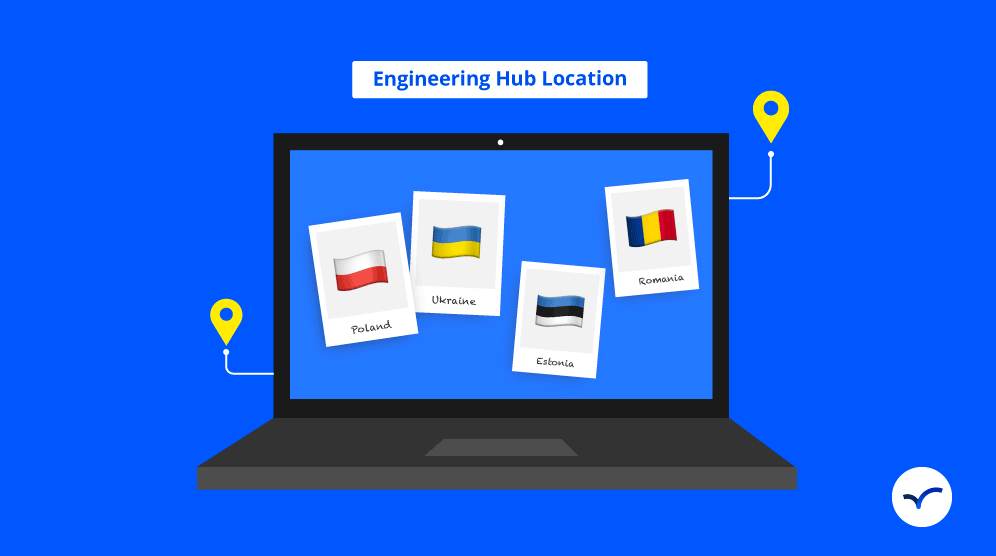Ukraine, Poland, Estonia, and Romania are amongst the top four locations in Central & Eastern Europe (CEE) you should consider if you are looking to establish a tech hub.
Why do tech leaders consider these locations for their next tech hub? Primarily due to the:
- Highly-skilled tech talent that is available at very affordable rates
- High proficiency in English
- Low costs of living
- Attractive government incentives, and
- The proximity to major markets in both Western Europe and Asia
If you’re short on reading time, we’ve summarized the key information on these four countries in the table below.
Of course, we encourage you to do your own research into these potential tech hub locations, and seek on-the-ground advice if you plan to establish a team there!
Looking to hire the best remote talent? See how Arc can help you:
⚡️ Find the world’s top developers, designers, and marketers
⚡️ Hire 4x faster with fully vetted candidates
⚡️ Save up to 58% with global hires
Hire top talent with Arc risk-free →
Ukraine vs Poland vs Estonia vs Romania — Overview

STEM Talent
CEE is home to a large pool of qualified STEM talent at rates that are extremely attractive for employers.

Ukraine
Ukraine counts over 800 institutes of higher education. Three of the country’s universities rank in the top 100 of the QS Emerging Europe & Central Asia (EECA) University Rankings 2020.
It produces around 130,000 engineering graduates each year. This is much higher than in many other European countries, including Germany and France. In addition to this, Ukraine is home to the largest share of IT graduates of any CEE country with over 16,000 IT graduates every year. In total, there are around 200,000 IT professionals in the country.
Poland
There are more than 500 universities in Poland, with the majority of them in the private sector. However, 14 of Poland’s tertiary institutions rank in the top 100 of the EECA University rankings. Impressively, three of those universities fall in the top 15.
Each year, Poland has around 118,000 engineering graduates. As a result, there is a generous supply of qualified local tech talent, making the country an excellent destination for hiring experienced developers.
Read More: 14 Toptal Alternatives to Hire Freelance Software Developers & More
Estonia
With a smaller population in the country, Estonia only has 24 universities. However, three of them make the top 100 list of the EECA 2020 rankings.
Estonia has approximately 3,200 STEM graduates per year, which is significantly lower than other CEE nations (unsurprising given its relative size). However, what the country lacks in numbers it more than makes up for with its commitment to technology. Home to four unicorn startups, Estonia leads the entire world with the most unicorns per capita.
Romania
Romania has 57 total universities. Six of them are in the top 100 of the EECA University Rankings 2020, with two in the top 50. The country has a sizable market of highly-skilled talent to choose from when it comes to engineering and software development.
In fact, nearly 20% of all Romanian graduates studied engineering at university. Not only is this a considerable percentage, but it shows Romania’s dedication to the tech industry. Despite a relatively small population, Romania has two unicorns to its name.
Read More: Canada, Mexico, and Argentina: Where to Build Your Engineering Hub
You can also try Arc, your shortcut to the world’s best remote talent:
⚡️ Access 350,000 top developers, designers, and marketers
⚡️ Vetted and ready to interview
⚡️ Freelance or full-time
Try Arc and hire top talent now →
Existing Tech Hubs
There is a balance of multinational tech companies and local powerhouses in the CEE region. We will provide two examples, one local and one international for each country.

Ukraine
Ukraine’s growing tech talent pool of nearly 200,000 software developers, has made multinational organizations take notice. Consequently, Kyiv and Lviv have become the two main cities where companies seek to establish tech hubs.
- Google — Google chose Kyiv to open their R&D center in 2020. In fact, this marks the third of eight Google offices in the CEE region. The center’s current aim is to improve Google’s Cloud service by expanding support and adding new features for its users.
- Softserve — Founded in Lviv in 1993, Softserve is a local company that has grown to become one of the largest IT firms in Europe. Presently, Softserve provides services in the IoT, DevOps, cloud computing, big data, and e-commerce. Additionally, the company’s list of clients includes the likes of Microsoft, General Electric, and Google, showcasing the success it has achieved.
Poland
In recent years, the Polish IT market has grown at a steady rate of 5-10%. Gdansk and Warsaw are two of the major cities that have become tech hotspots for multinational and local companies alike.
- Amazon — E-commerce giant Amazon chose Gdansk, as the location for its development center. Specifically, they have a team of over 650 highly skilled R&D employees there with plans to keep expanding in the future. The development center employs natural language processing scientists and software development engineers for their Alexa-based products. In this situation, the reason for their choice is primarily the easy access that Poland gives to European markets.
- WASKO SA — Renowned as one of the leading pioneers in Polish IT services, WASKO SA delivers solutions to medium-sized businesses and large enterprises. They predominantly work with clients in telecommunications, banking, and energy in addition to public and governmental administration. Their primary specialty is in designing and producing software and rendering complex services for the maintenance and exploitation of IT systems.
Read More: Hiring In-House vs Remote Developers: Cost & Competitive Advantages
Estonia
Tallinn and Tartu are the two major Estonian cities where major companies are setting up tech hubs. Concurrently, the government has made radical changes over the years to digitize the country’s systems. As a result, Estonia has become an attractive location for progressive tech enterprises.
- Skype — A small Estonia-based startup founded Skype, which Microsoft later acquired in 2011 for $8.5 billion. What was once a small idea for a peer-to-peer VOIP software program has now become a household name worldwide. Fast forward to today, and Skype still has offices in Tallinn and Tartu. Various government incentives create an excellent business environment, and Skype expects to continue on an upward curve for many years to come.
- HQSoftware — Founded in 2001, HQSoftware has provided custom software solutions to many high-level clients. Their smaller team consists of 76 professionals that work to deliver complex solutions to clients from various industry sectors. Their services include custom software development, software engineering, and mobile app creation, to name a few.
Romania
Bucharest and Cluj lead the way when it comes to software development in Romania. The quality of connectivity and infrastructure, concentration of affordable talent, and availability of skills make these major cities desirable destinations to establish tech hubs.
- Microsoft — One of the world’s leading technology companies, Microsoft, set up in Romania since the late 90s. But in 2006, they opened one of the largest technical centers in Europe in Bucharest. This center now acts as a partner for smaller businesses and independent software developers, while also supporting local talent. Their main reasons for choosing Romania are the excellent level of English and the affordable costs of developers.
- UiPath — In 2018, Romanian startup UiPath grew exponentially from a value of $1 billion to $3 billion. As a result, it became the first Romanian unicorn company. In essence, UiPath is a leading Robotic Process Automation vendor that has helped countless organizations automate their routine business processes. And thanks to their impressive growth, they have expanded to ten other countries.
Read More: How Much to Hire a Software Developer: Freelance vs Full-Time Costs
Time Zones

Ukraine, Estonia, and Romania are all 7 hours ahead of Eastern Time (EST). Poland, on the other hand, is 6 hours ahead of EST.
For tech firms operating on Pacific Standard Time (PST), Poland is 9 hours ahead. Alternatively, Ukraine, Estonia, and Romania are all 10 hours ahead of PST.
This time difference enables US tech firms to reap the benefits of having an around-the-clock presence in different parts of the world and still have a few overlapping business hours.
Read More: How to Work Across Time Zones as a Remote Team: Best Practices
Level of English
The EF English Proficiency Index (EPI) is the world’s largest ranking of countries and regions by English skills. It ranks each country with a score based on their overall level of English proficiency.

Ukraine
Of the four countries, Ukraine has the lowest level of English proficiency, with an EF EPI score of 52.13. It ranks 49th out of 100 countries listed and 29th out of 33 European countries.
Poland
Poland has the highest level of English proficiency on the list, with an EF EPI score of 63.76. They rank 11th out of a possible 100 countries and 9th out of 33 European countries.
Estonia
Estonia has a high level of English proficiency, with an EF EPI score of 58.29. It ranks 28th worldwide and 22nd in Europe.
Romania
With a high score of 61.36, Romania is second to Poland on this list. It has a high level of English proficiency, ranking 16th worldwide, and 14th in Europe.
Read More: Freelance Developer Hiring Guide
Lifestyle
All four CEE nations have a rich cultural heritage. This means there is plenty to do and see for people with vastly different interests.

Ukraine
Aside from low living costs, Ukraine has a lot to offer for its residents. It boasts several world heritage sites, including the ancient city of Chersonesus and Saint-Sophia cathedral. Additionally, Ukraine has access to the magnificent Black Sea in the South, home to incredible wildlife.
Poland
Sandwiched between six other European countries, Poland has excellent connections to most of Eastern Europe. From impressive mountain ranges to medieval architecture, there’s a lot to see and do. In the North of the country, you will find spectacular views along the coastal regions that border the Baltic Sea.
Estonia
Estonia is one of the most forward-thinking countries on the planet. For example, their introduction of online voting is just one of a long list of global firsts.
Aside from the progressive environment, you won’t run out of things to do in Estonia. It has 28.4 people per km, making it the least crowded country in Europe. There are also a few world heritage sites.
Romania
Romania has a vibrant history and culture. It has one of the most extensive rail networks in the world, stretching a total of 22,298km. This makes it easy to see many sights throughout the country.
Visitors can see the wooden churches of Maramures, the impressive Voronet Monastery, the Parliament (the second largest building in the world), and Dracula’s Castle (also known as Bran Castle).
Read More: 10+ Things to Consider BEFORE Hiring a Freelance Software Developer
Cost Of Living
Using Numbeo (the world’s largest database of user-contributed data about cities) we can compare each of the four countries using their capital cities as a reference point.
Choosing the capital city is necessary because rural areas and smaller towns in Eastern Europe may have significantly different costs of living. These are not representative of the bigger cities where companies like to set up tech hubs.
The following figures are all in US dollars.

Ukraine
Kyiv has one of the lowest overall living costs of all four capital cities. On average, rent for a 1-bedroom apartment in the city center is $605.56 per month. An average 3-bedroom apartment in the city center costs $1056.88 per month to rent. Essential utilities (electricity, heating, cooling, water, and waste) cost $100.93 per month on average.
The average cost of a monthly public transport pass is $12.96, while gas is $1.09 per liter. Overall, rent, transport, and utilities account for 49.7% of monthly living expenses.
Poland
In Warsaw, the price of rent is on the upper end of the scale. It costs $725.81 for a 1-bedroom city center apartment and $1257.21 for a 3-bedroom city center apartment. Essential utilities are around $160.07 on average.
A regular public transport pass will set you back $26.36 while gas prices come in at $1.20 per liter. Thus, rent, transport, and utilities equate to 52.2% of living expenses.
Estonia
In Tallin, rent for a 1-bedroom apartment and 3-bedroom apartment costs $587.90 and $952.37, respectively, on average. Essential utility costs are around $195.88 every month.
The average price of a monthly public transport pass is $26.06, and gas costs $1.48 per liter. Overall, rent, transport, and utilities amount to 43.4% of the total monthly expenses.
Romania
Bucharest has an overall low cost of living. Rent for a 1-bedroom apartment in the city is $452.98, and the average 3-bedroom city apartment costs $781.65 per month in rent. The average price of essential utilities is around $100.73. This includes electricity, heating, cooling, water, and waste.
A regular public transport pass will set you back $15.71 on average, while gas costs around $1.27 per liter. This means that rent, transport, and utilities add up to 41.7% of total expenses.
Read More: Andela vs Toptal vs Turing vs Arc: Which is the Best Andela Alternative?
Developer Salaries

Average salary information is crucial whether you want to find the best location to hire remote developers or establish an engineering hub. Average salary data on the four CEE nations is provided below.
| Av. Dev Salary | Av. Senior Dev Salary | |
|---|---|---|
| Ukraine | $46,686 | $54,777 |
| Poland | $54,316 | $65,703 |
| Estonia | $46,393 | $53,946 |
| Romania | $70,877 | $82,321 |
A further breakdown of salaries by development role is in the table below. The review uses data from the Arc Remote Developer Salary Tool and the Glassdoor salary index:
| Front-end | Back-end | Data Science | App | DevOps | |
|---|---|---|---|---|---|
| Ukraine | $44,641 | $45,495 | $48,760 | $44,188 | $49,115 |
| Poland | $49,810 | $52,076 | $56,894 | $51,351 | $59,363 |
| Estonia | $31,797 | $35,293 | |||
| Romania | $72,571 | $72,645 | $70,339 | $66,165 | $75,066 |
Other Incentives Driving Tech Growth
In addition to the factors previously mentioned, numerous incentives are driving leading organizations from around the world to invest more and more resources in CEE countries.

Ukraine
Ukraine is outside the EU. This means most aspects of the complicated and often restrictive GDPR privacy rules are not applicable. As a well-established tech hub for multinational companies, the government has continued to pump millions of dollars in funding to help propel further industry growth in the country.
There is, however, a high level of bureaucracy. It is, therefore, best to forge collaborative working relationships with local professionals with better knowledge of the relevant procedures.
Citizens of the United States are eligible to visit Ukraine without the need for a visa. This is under the conditions that the stay does not extend beyond 90 days in any given 180-day period.
Poland
Poland is one of the few EU countries to report a decrease in real labor costs for over a decade. This is unheard of in most parts of the world, considering the quality of talent coming out of the country. In addition to this, the government has incorporated financial incentives from both EU Funds and local sources for tech firms operating in the country.
As a Schengen member state, U.S. citizens can enter Poland for a maximum of 90 days for business or tourist purposes without a visa. Upon entering, they have free movement and excellent access to any of the 26 member countries throughout Europe.
Estonia
The Estonian government has shown full support for the tech industry since the 1990s movement “e-Estonia.” This commitment to R&D and innovation has led the country to become one of the most digitized nations on earth. Its simple bureaucracy — in conjunction with a favorable tax system and the e-residency scheme — makes it easy to set up a paperless EU company.
In 2019, Estonia released an official visa for ‘digital nomads.’ It allows foreign nationals to work in the country all year round. The permit attracts the best tech professionals from around the world to the country’s shores.
Romania
With the IT industry contributing over 6% of national GDP, the government has implemented initiatives to drive further growth. One of the various laws makes IT professionals exempt from personal income tax. The 10% saving on income tax is appealing to both employers and employees alike. In Romania, employers are responsible for withholding employees’ taxes and paying them to the government.
As a disadvantage, Romania’s legal system has a high level of bureaucracy, so it’s best to establish partnerships with local companies or relocate a senior manager there that knows the language. On the positive side, Romania offers a very welcoming culture, and any American citizen can enter Romania without a visa for 90 days in any 180-day period.
Read More: 10+ Software Engineer Interview Questions to Find Top Dev Candidates
Wrap Up
Ukraine, Poland, Estonia, and Romania are brimming with top-tier tech talent at some of the most affordable rates on the planet.
When you factor in the attractive government incentives, the general lifestyle, and a high level of English, among other factors, it’s easy to see why these four locations are ideal for your next engineering team.
Looking to set up a tech hub of your own, or find remote developer talent in one of these locations?
You can also try Arc, your shortcut to the world’s best remote talent:
⚡️ Access 350,000 top developers, designers, and marketers
⚡️ Vetted and ready to interview
⚡️ Freelance or full-time








